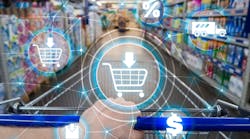As the shopping experience has changed due to a number of factors including a global supply chain crisis that limited product selection, inflation and currency issues have also impacted the price of goods on a global scale. Additionally, consumer expectations have increased. Consumers are now looking for retailers to accommodate their personalized shopping preferences, both online and in-store.
According to SOTI's new global research report The Tech Effect: Strengthening the Omnichannel to Meet Consumer Demands, retailers that do not leverage technology to enhance online and in-store shopping experiences risk losing consumers to competitors quicker than in previous years.
2022 Created Consumer Shopping Challenges
The 2023 retail report outlines that economic and supply chain issues made it difficult for U.S. consumers to shop, as 85% experienced availability, pricing and shipping issues. This has prompted consumers to keep an eye out for solutions to these factors before making a purchase online or in-store:
Other issues of concern are as follows:
- Delivery charges are more expensive 62%
- Items are more expensive 55%
- Items are no longer available 53%
- Delivery times are slower than usual 36%
The Best of Both Worlds
With consumers identifying numerous challenges, the retailers that offered the most seamless shopping experience, online and in-store, thrived. The report found 47% of U.S. consumers still prefer to shop online. While emphasizing the strength of e-commerce, the research confirms a consistent leaning towards a hybrid shopping model. This provides retailers an opportunity to merge strategies from both worlds and fix consumer pain points.
In this hybrid shopping model, consumers seek retailers to offer enhanced and more personalized experiences. In fact, 51% of U.S. respondents prefer to shop with retailers who offer an experience based on their individual preferences.
“It wasn’t long ago that retailers could put their different channels in silos and report strong bottom lines,” said Shash Anand, SVP of Product Strategy at SOTI, in a statement. “Now, they need to deliver a seamless and personalized shopping journey that can only be achieved through technology. With a connected and digitized backend infrastructure, as well as mobile tracking technology, retailers can instantly obtain real-time information, remain transparent with consumers and give online shoppers the choice of how they want items fulfilled.”
Transaction Deal Breakers
Both the purchasing and fulfillment processes are important to consumers. Close to two-thirds of U.S. consumers expect to know where their order is within the delivery process at all times, while six-in-ten continued shopping with brands that could deliver goods the fastest. In fact, over one-third of U.S. consumers agree that knowing a retailer's delivery partner determines whether they will complete an order.
When it comes to ordering items, the top options for U.S. consumers are in-home delivery by any method (66%) and delivery in-store or to a designated drop-off point (28%). In addition, 68% said delivery time and speed are still the most important, followed by returns, with 55% stating they are more likely to shop from an online retailer that provides multiple options to return a product.
“With delivery charges increasing and delivery options broadening, retailers need to carefully vet their delivery partners to ensure they can fulfill heightened consumer expectations. In updating both hardware and software across their entire supply chain management processes, physical warehouses and stores, retailers and their partners can better inform consumers of product availability and delivery timelines while ensuring they are getting the most bang for their buck,” added Anand.
The Grass Can Be Greener on the Other Side
As consumers become more conscious of their spending and the brands they shop from, carbon impact is becoming a new deciding factor. The report echoes this sentiment with over half of U.S. consumers (55%) agreeing that they prefer a more sustainable way to return goods. Additionally, 41% of respondents agree that they would prefer to shop with a retailer offering carbon offset and more recyclable packaging.
“Looking ahead, retailers will need to prioritize how they communicate with logistics partners. Optimizing and increasing the deployment of mobile device fleets across the entire supply chain for sustainable, smooth delivery and returns while creating a flexible hybrid business model and communication across supply chains will become vital in mastering the consumer-retail experience. Retailers who understand consumer pain points will lock in consumer loyalty at a time when markets are volatile and goods are more expensive,” concluded Anand.



